The common name “Blackbird” refers to any medium to small-bodied bird with an overall dark aspect (feather coloration). In scientific terms, Blackbirds are a genus of avians belonging to the phylogenetic family Icteridae.
The fastest way to determine if you are looking at a Grackle is if it’s larger than a robin but smaller than a crow, with iridescent feathers and a long spear-shaped beak.
If you look at a Blackbird, the size will be more similar to other songbirds, though they can appear slightly chunkier. There will be patches of red, orange, or yellow coloration on an otherwise all-black body. The beak is usually broad at the base and tapers into a very sharp point.
These are the quick and easy answers to the question “Grackle vs. Blackbird.”
However, there is a lot more to these birds than just this simple breakdown.
To keep our system manageable, we will order the characteristics of a Grackle vs. Blackbird into three steps.

These steps are the bird’s body shape and size, its feathers and coloration, and the beak’s shape and size.
We could easily dive into a dozen more options to look into. However, I think if you can nail these three essential items, you will be able to know for sure what member of Icteridae you’re observing.
This may be tricky to conduct in the field without a camera or a pair of good binoculars, but if you manage to get a good look at the bird, you can conclude what you saw.
If you would like to learn more about some of the other members of this family, please check out my other article, 5 Members of the Blackbird Family – What is a Blackbird.
The two species I will be referencing throughout this article will be the Boat-tailed Grackle (Quiscalus major) and Red-winged Blackbird (Agelaius phoeniceus).
I think these species perfectly represent their respective groups.
After we discuss these different characteristics for identification, we will go over some of the exceptions to these rules.
But first, let’s jump into the first and most observable characteristic we can observe, the bird’s body shape and size.
Body Shape & Size
All of the members within Icteridae are medium-sized songbirds, some being smaller than others.
You will not find one of these birds smaller than a House Sparrow and none bigger than an American Crow.
If you’re looking at a “Blackbird” that is about the size of a house cat, you are probably looking at a crow and not an Icterid.
Grackles (Quiscalus) are easily the biggest among their cousins, followed by Larks (Sturnella), Blackbirds (Agelaius & Euphagus), and finally Cowbirds (Molothrus).
Grackles average about 12 inches in length from tip to tail, while Blackbirds only average slightly over 8 inches long.
These size rules are based on the average length of the birds and are a general trend to get started with your identification. Keep in mind the region, age, and sex of the bird you are identifying. These factors can affect our bird’s appearance (more on this in the sections to come).
Sticking to our Grackles and Blackbirds, they are straightforward to distinguish if side-by-side.
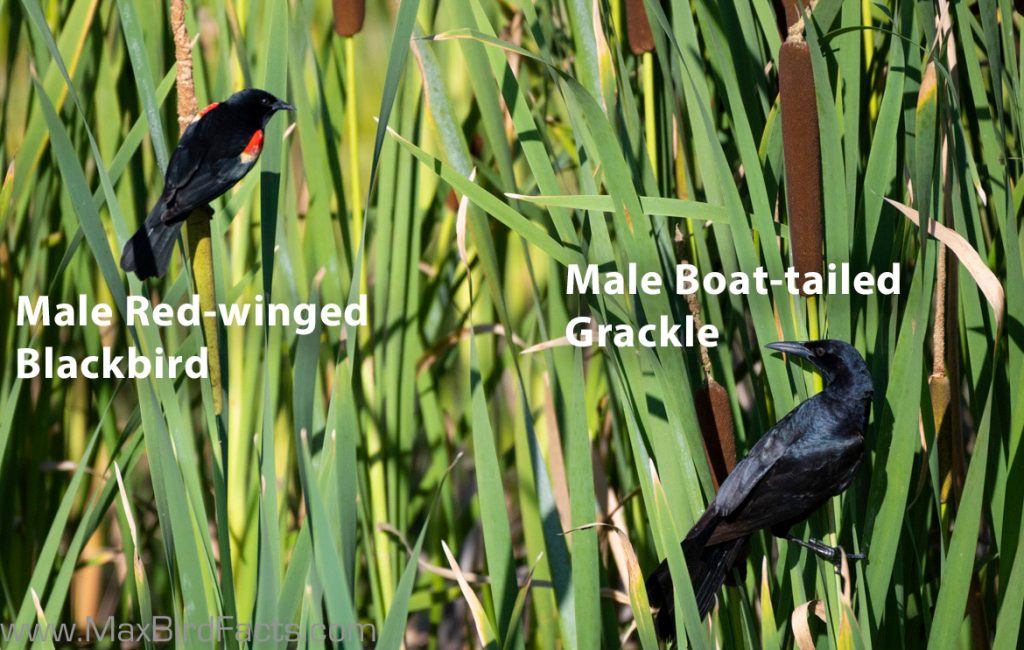
The problems can come with an isolated image or sighting with no accurate scale, and this is why we look at their posture.
Grackles are very upright when they walk and perch, giving them a lean appearance. Standing with their feet directly below their shoulders, neck, and head angled outwards, and the tail very far being the body.
This stance allows the Grackle to keep a good lookout for predators or rivals while searching for food.
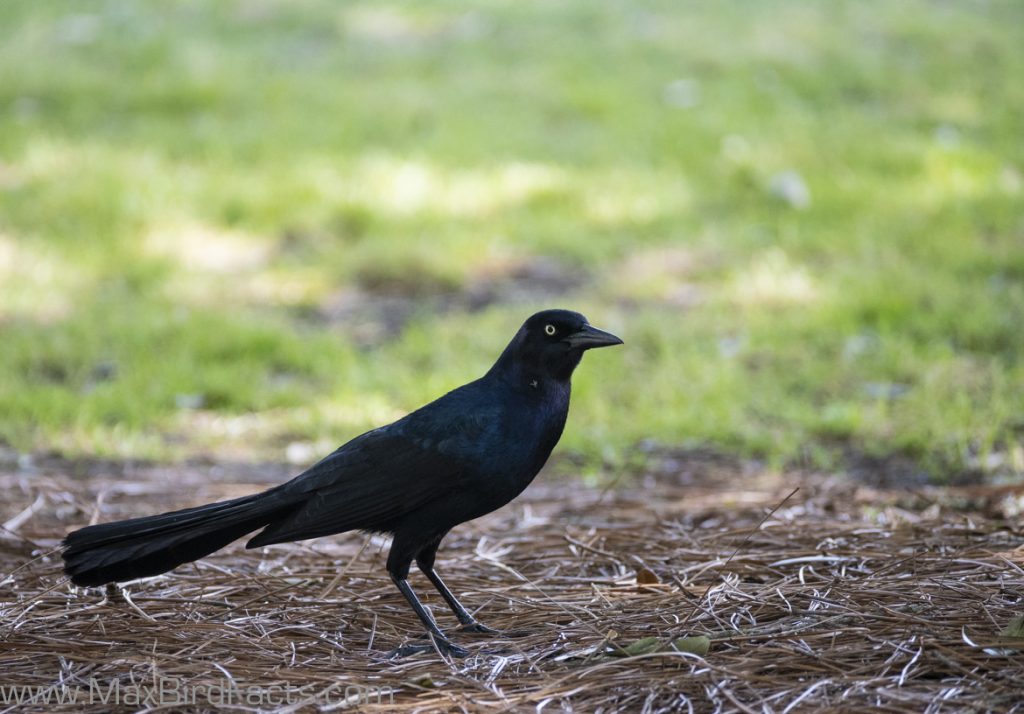
While walking, a Grackle will bob its head forward and back slightly while its tail stays extended towards the ground. This movement helps keep the bird balanced while foraging.
Blackbirds will stay somewhat tucked in when they are perched—opting to keep their head and neck closer to their body to give a slightly chunkier form.
The body shape itself is more rounded, with an apparently short neck and barrel-chested appearance. The Blackbird’s head is also very round, with no prominent crest or features.
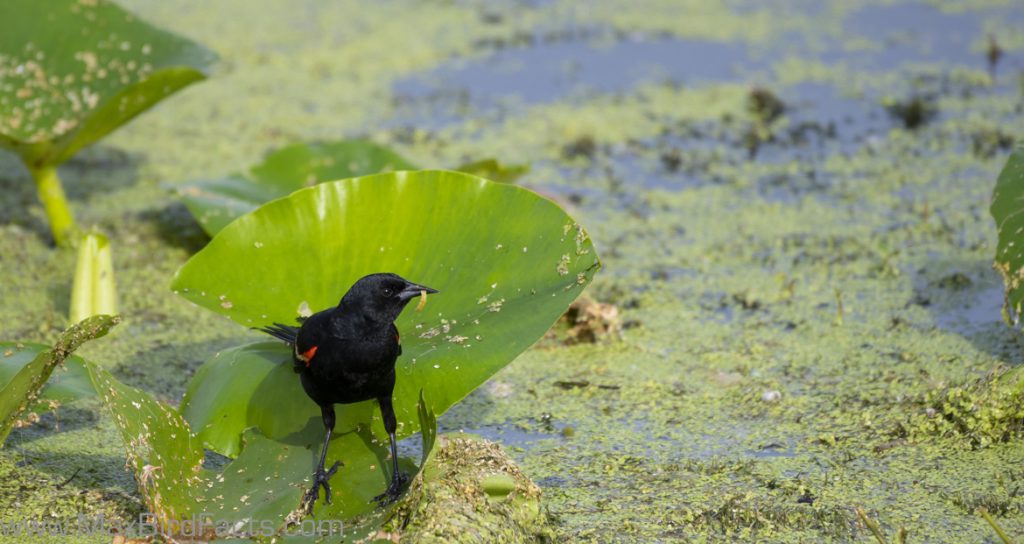
Some species of Grackle will have a rounded crest that extends while calling or making displays. This is not true for all Grackle species.
For example, Common Grackles have a slightly flat appearance to the top of their head. This is caused by the lack of crown feathers, instead just contour feathers to protect and insulate the bird.
The legs, feet, and talons on Grackles are also notably more prominent than a Blackbird’s.
I’m not sure why the Grackle’s feet appear so large, possibly to allow them better grasping and stability when stalking on the ground or perched on a reed.
Blackbird feet are significantly smaller. This appearance could easily be from the massive difference in size between the two genera, Grackles being around 33% larger than Blackbirds.
The exposed skin along the legs is glossy black between both groups.
The Grackle’s legs also appear larger than the Blackbird’s, but the overall size difference could again cause this.
The tails of these two groups of birds can vary wildly within their own classifications.
The Grackle’s tail will be more rectangular and elongated than the Blackbird’s.
In some species, a Grackle’s tail can be visibly greater than the entire length of the body, making it one of their most striking features. The tail size alone could be the only feature needed when determining if you see a Grackle or Blackbird.
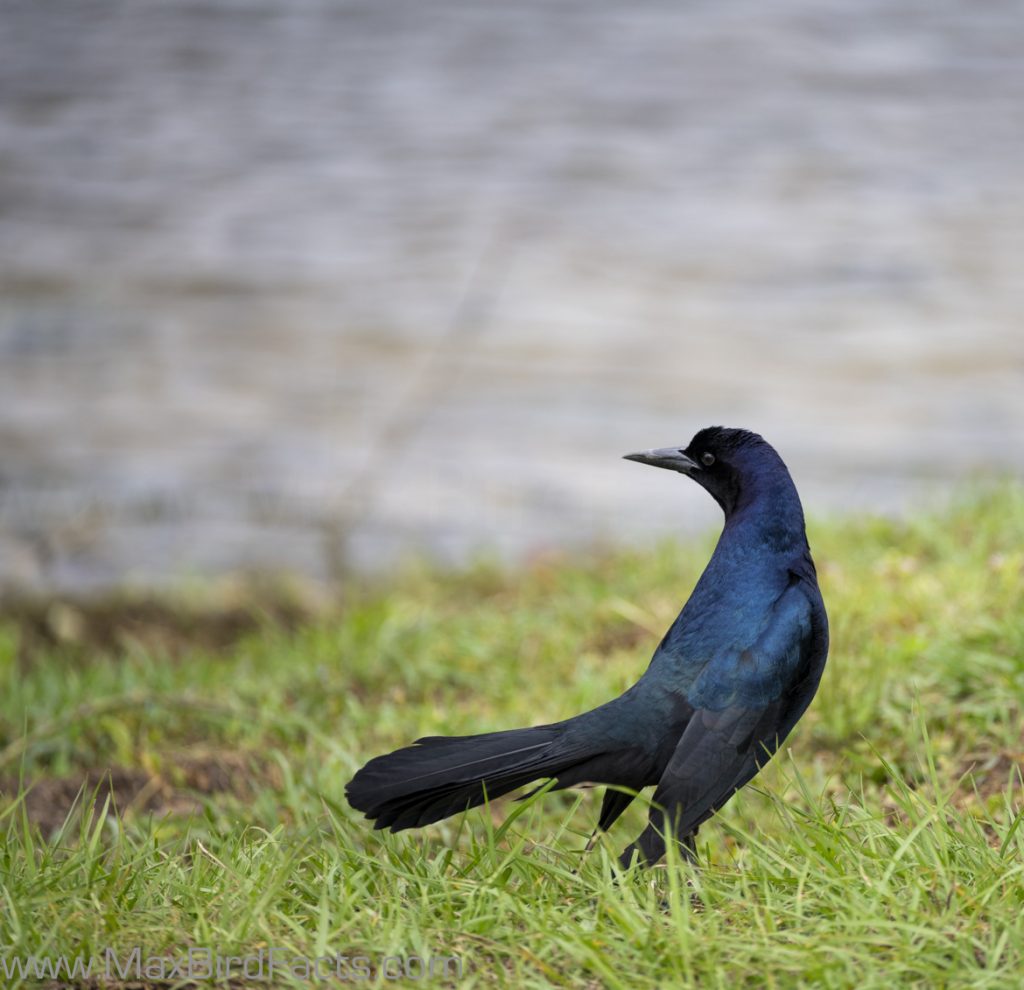
When a bird takes flight, it will at least partially fan its tail, and this is the perfect moment to take note of its shape.
A Grackle’s tail will be at least 50% of its body length (Common Grackles) and up to the entire length of the body (Boat-tailed Grackles).
These long tail feathers have a rounded, almost wedge-shaped appearance, tapering slightly from their attachment at the body to a widened end.
A Blackbird’s tail is much more reminiscent of a traditional songbird’s.
The classic fan-shaped tail is exceptionally versatile and very functional. It is perfect for fast maneuvering while also staying tucked out of the way.
The Blackbird’s tail is no more than one-third the length of the bird’s body. The shorter feathers also allow the Blackbirds to maintain them with less effort than their larger, leaner cousins.
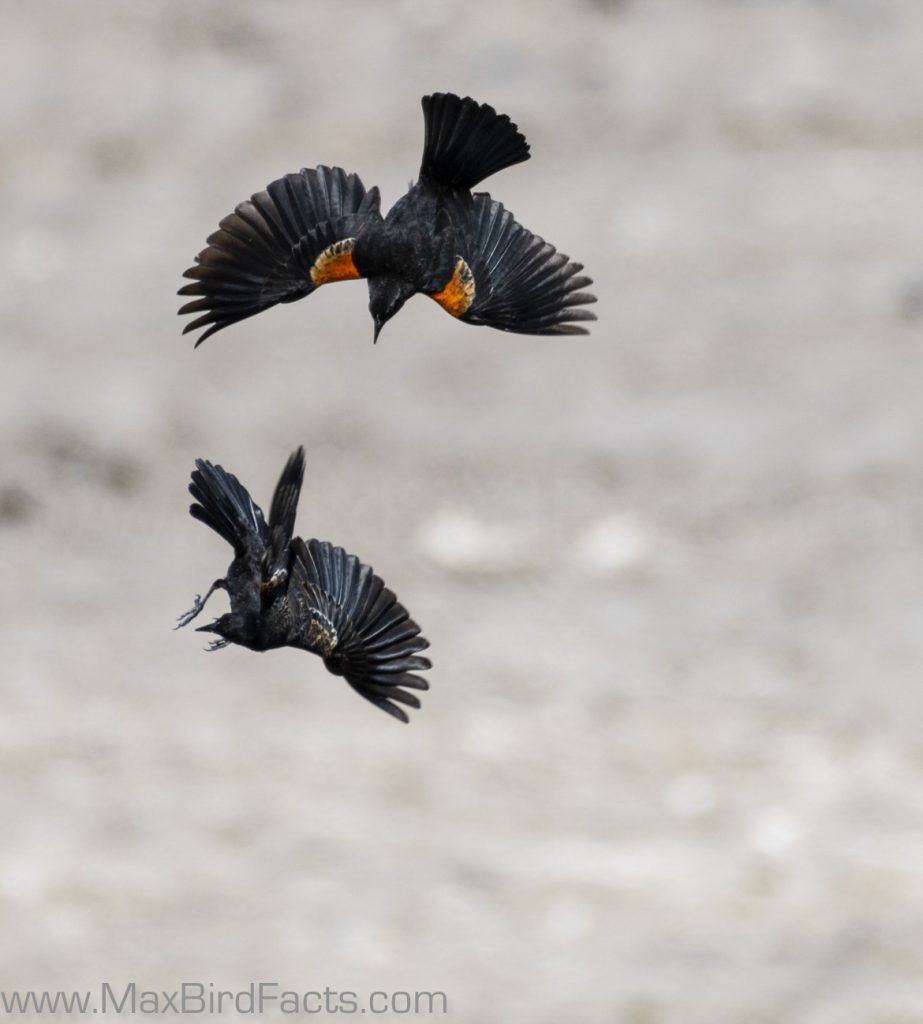
The size of the Grackle’s tail isn’t just for flying; it is also a flag. The longer the tail, the more successful the male must be at fending off rivals and finding food.
These are both aspects that females look for when breeding, and this honest signal has caused these birds to have proportionally massive tails. An honest signal is where the message being sent cannot be altered to make the sender appear more attractive.
The most common examples of honest signaling are feather coloration and condition. These cannot be faked because they are directly showing the health of the bird. Think of your hair or grooming.
Suppose you haven’t shaved in a couple of days or didn’t brush your hair in the morning. In that case, this will be very apparent to the people around you, and they probably won’t think very highly of you.
Now that we have the body size in mind, let’s look at the feathers’ color and aspect.
Feather Aspect & Coloration
The vast majority of this family is drably clad, consisting of browns and blacks.
However, once the light hits a Grackle’s feathers at just the right angle, they light up with green, blue, and purple.
The surface of the feather causes the male Grackle’s iridescent aspect.
The feather’s barbules create microscopic air pockets that bend and refract the light to produce beautifully hidden colors through coherent scattering.
The way these barbules are packed will change the way the iridescence appears.
If the bird hasn’t preened enough, and the feathers are messy and not straightened, the refraction may not work, and the male will not appear attractive.
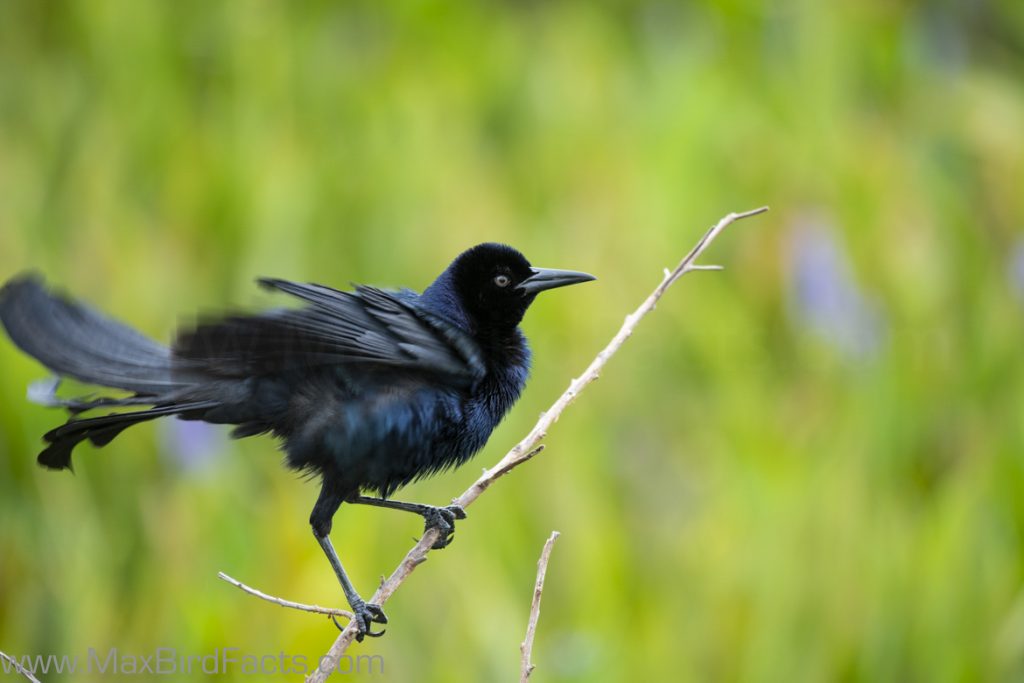
Again, our example of brushing our hair in the morning, preening and grooming, is a massively necessary chore. Having feathers sticking whichever way they want will not impress a female and reduce the success of a male Grackle.
If you go on a date without brushing your hair beforehand, you probably won’t get called back.
Coherent scattering is crucial to blue coloration in birds. This is achieved through a particular arrangement of these air pockets. Because of this, the color blue is one of the rarest in nature.
Compare this to the colors of a Blackbird. An all-black body with splotches of coloration on primary points of attention.
These patches of brilliance are on the wings, shoulders, head, or breast, depending on the species.
Pigmentary coloration creates red, orange, and yellow Blackbirds use for their primary coloration.
Unlike the iridescent colors in Grackles, the food Blackbirds eat directly influences their coloration.
Carotenoids are a group of pigments found in foods that the birds process to create their vibrant colors.
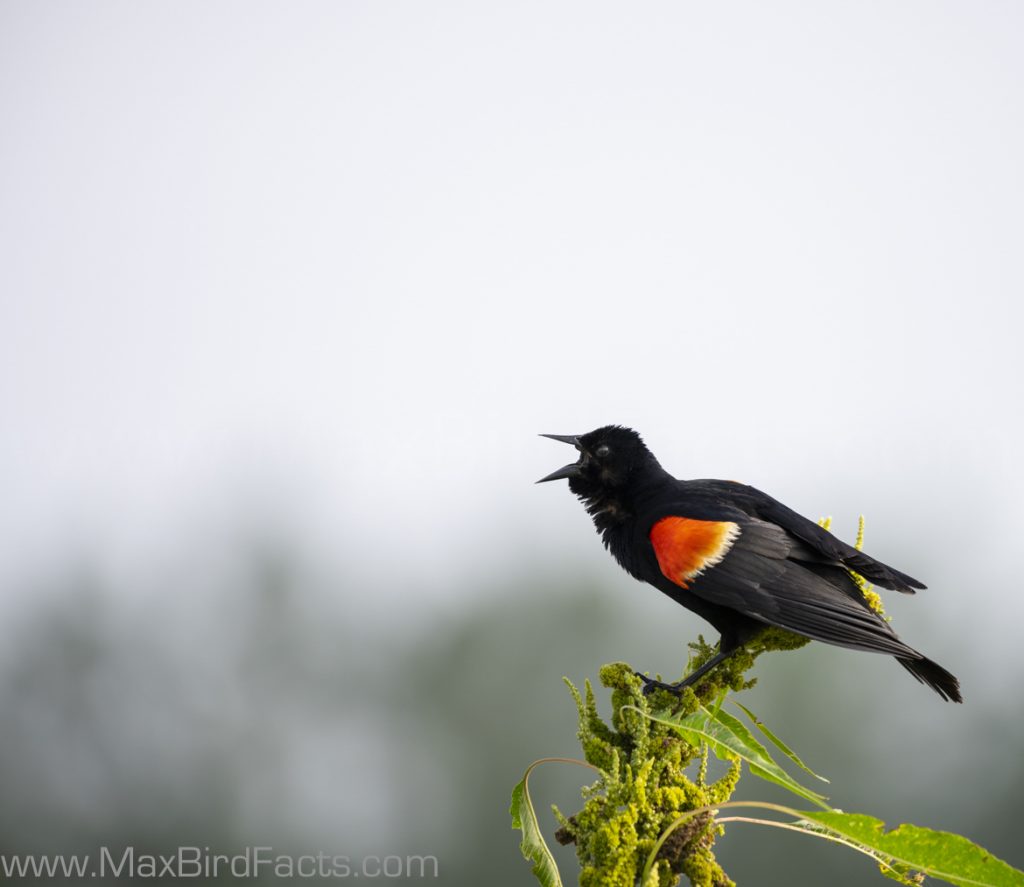
The drawback to this form of coloration is if the bird doesn’t find enough good quality food rich in carotenoids, their aspect will suffer.
This fact is true in any bird with the red, orange, yellow, or pink aspect to its feathers. Flamingos are some of the most famous and well-known examples of this, where they become pink because of the shrimp they eat.
The shrimp themselves don’t contain carotenoids; these are found in the vegetation and algae they eat. As the shrimp consumes this plant material, carotenoids accumulate in their body.
Once the shrimp enters the Flamingo’s digestive system, enzymes and lipids can unpack this complex chemical to extract the color they need. This color is then transported into the fatty tissue of the bird, found just below the skin, and is what feeds nutrients into the feather’s cells.
If you’d like to learn more about this fantastic behavior and system, check out my article Why Are Flamingos Pink – Pigmentary Coloration in Birds.
Back to our Blackbirds, this is essentially the same process. Instead of consuming the animals that eat the plant material, Blackbirds find the carotenoids by eating the vegetation directly.
Fruits, berries, flowers, and many other plant structures are filled with this vital resource.
Like the tail size being an honest signal, the colors on a Blackbird are also an honest signal.
If a male Red-winged Blackbird cannot find enough berries rich in carotenoids, his epaulets will not be as brilliant red as they should.
This will tell females and other males that this individual isn’t successful in defending a territory and will be less likely to pass his genes to the next generation.
The problem with these pigmentary colors is they are always visible. Compared to iridescence, the light has to strike the plumage at just the right angle to show the blues and purples. Pigmentary coloration permanently changes the color of the feathers to red, orange, or yellow.
This could be a problem when trying to hide from predators or disguise yourself not to get attacked by a rival male.
Red-winged Blackbirds have an ingenious solution to this, cover up the red patches. It seems pretty obvious, but they do it in a very clever way.
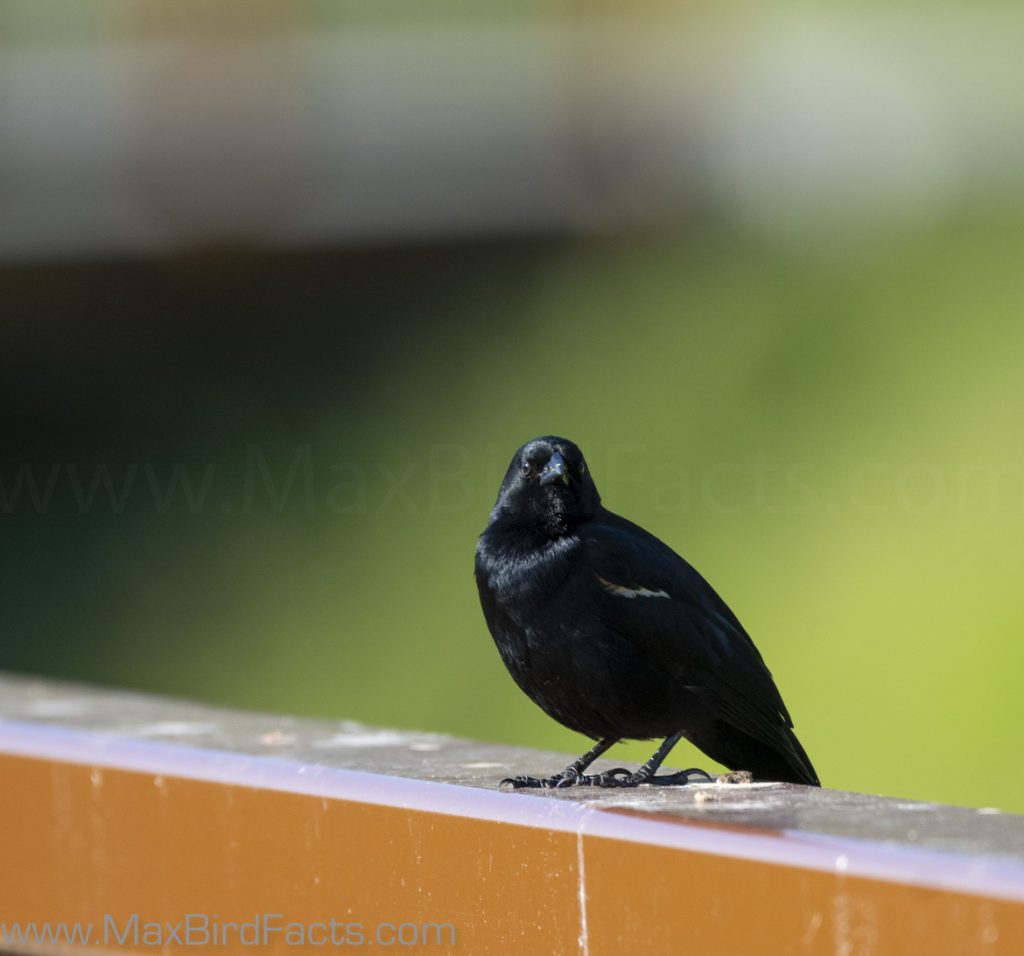
Covert feathers that line the wing’s dorsal (top) side can be stretched to partially or fully cover their epaulets. Having the ability to hide the red patch of the epaulet somewhat could be a way for a male to sneak into another’s territory while appearing like less of a threat.
My theory is that a male who hides only part of the red patch is still advertising that they are sexually mature while still saying they are not willing to compete with the other males in the area.
They can go about feeding, preening, singing, and any other function without the risk of being attacked by a more territorial male.
They can switch at an instant by removing the covert feathers and revealing the whole epaulet. Now the male can show off to females their fitness and start interspecific combat with rival males.
Again, this section is pretty simple to use once you’ve determined the size and shape of the bird.
If it has iridescence, it is more than likely a Grackle.
If it has patches of red, orange, or yellow on its wings, head, or breast, it is probably a Blackbird.
Beak Shape & Size
After going through our mental checklist inside the first two sections, you should have a pretty good idea of what you’re looking at.
Our third step of inspecting the beak of our unknown bird is almost a formality, giving us a nearly 100% certainty of our Icterid.
I love looking at a bird’s beak, so much fine detail in such a striking structure. This is no different with our Grackles and Blackbirds.
The whole Icteridae family has gone down a path of generalization. Their diet consists of nearly anything they can crush between their jaws, pick apart, or swallow whole.
Grains, seeds, flowers, fruits, berries, insects, crustaceans, fish, reptiles, amphibians, carrion, if you can think of it, these birds will probably eat it. This is a great way to survive. Not specializing in any specific food will allow these birds to flourish in nearly any environment.
The beak shape does vary between our genera, though.

Blackbirds tend to have a more triangular-shaped beak. The base being noticeably broad and having a distal tapering towards the tip.
The tip of the beak is a very refined point that is perfect for picking apart the fruits, flowers, and berries rich in carotenoids.
The edges of the bill are not very feature-rich. Relatively smooth lines allow this bird to retain the versatility they need.
The overall length of a Blackbird’s beak is slightly shorter than the head.
Grackles, on the other hand, have a much longer beak. Keeping with their lean and lanky appearance, the beak with these birds does taper from base to tip, but not as drastically.
Because the overall length of the beak is longer, the tapering is not as noticeable. This makes the Grackle’s beak have more of a cone-shaped appearance rather than the Blackbird’s triangular-shaped.
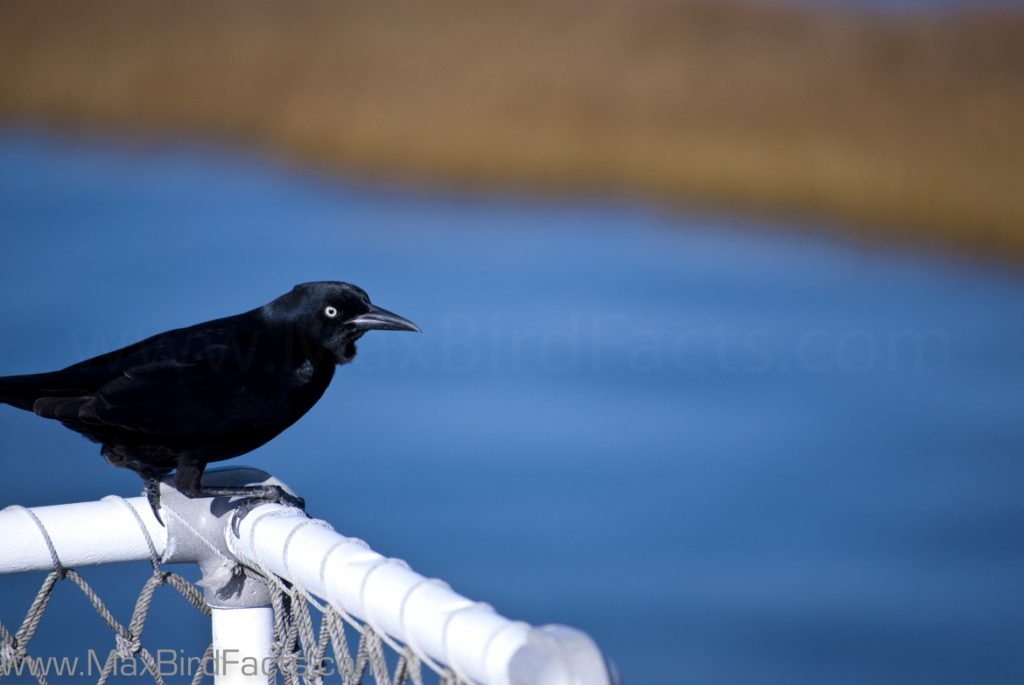
The tip of the maxillary (upper jaw) beak also has an apparent downward curve. This isn’t as pronounced as the curve in a hawk or falcon, but still something you can see without the aid of magnification.
This curve is perfect for picking apart flesh, precisely manipulating objects, or probing into hard-to-reach places.
Again, just like with Blackbirds, the edges of the beak are relatively plain and featureless.
This isn’t necessarily a bad thing. Again, the diet of both these birds is so broad that having any primary specialization in the beak would start to restrict what they can and can’t consume.
A Grackle’s beak length is the same, if not longer than its head. This gives them the ability to probe and pick at food that may not be as accessible to other birds or animals.
Just like our body size, a Grackle’s beak will be noticeably larger than a Blackbird’s.
Female Grackles vs. Blackbirds
Female Grackles and Blackbirds are very drab in appearance. Rather than having the iridescence or bright red epaulets, females will be almost entirely brown with some markings to aid camouflage.
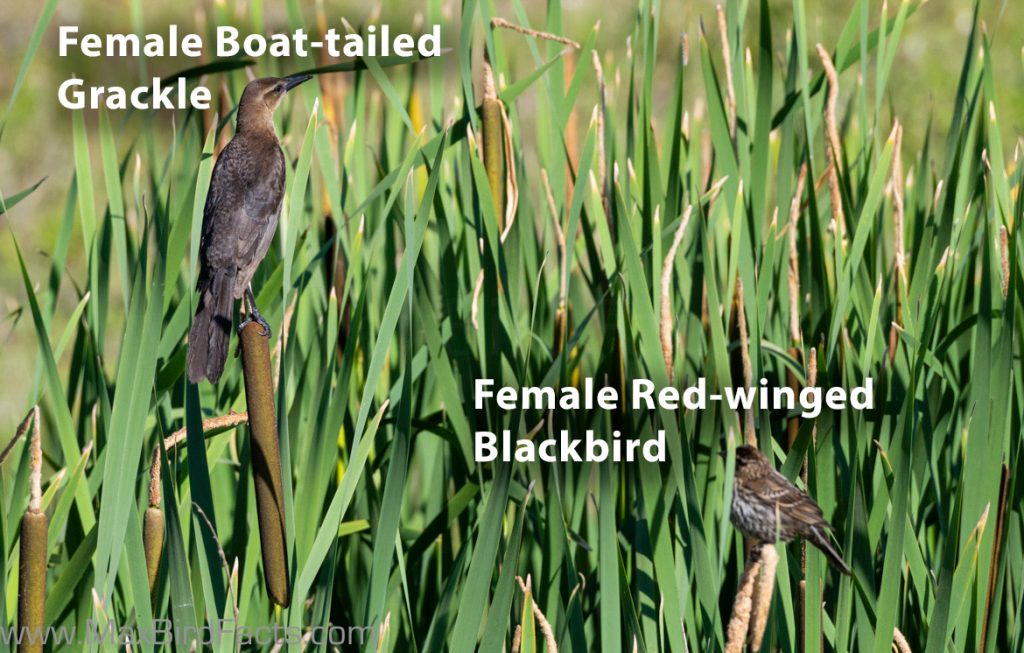
The cause of this is sexual dimorphism. Through sexual selection, male birds require showy feathers and displays to attract females. The females are more likely to mate with the male with the brightest colored feathers, the loudest and most energetic song, and many other considerations.
In this way, the female bird forces the males to become more apparent in their appearance and songs because they find this more attractive.
While the male becomes more flamboyant, the female will dress down.
This keeps her safe from predators, and because her plumage isn’t being judged, she can keep the more plain look.
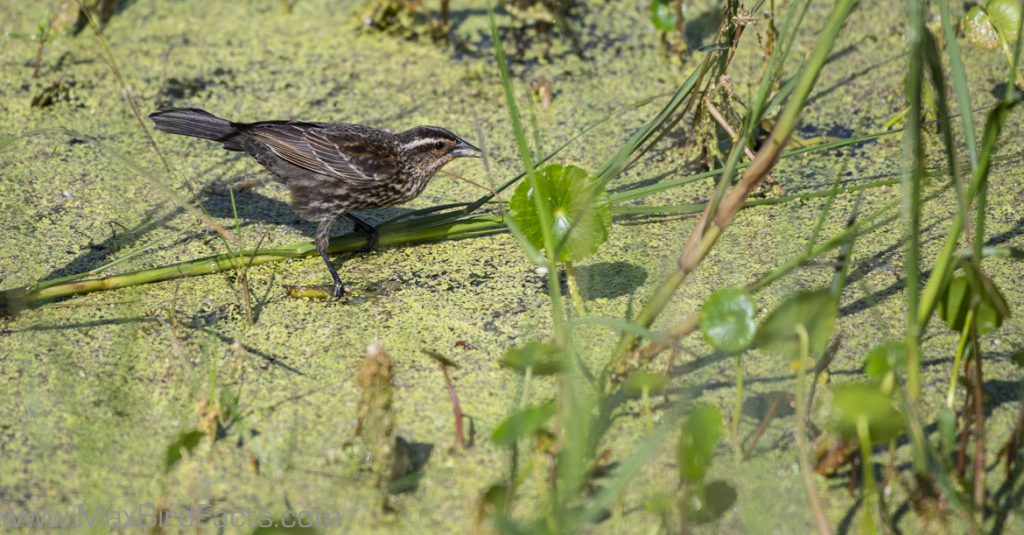
But can you still tell the difference between a female Grackle and a female Blackbird?
Yup! Primarily look at the body shape, and you will know almost instantly.
Female Grackles will appear as a slightly smaller, brown feathered version of the male. They will retain a lean appearance, upright posture, long neck, and long evenly tapered beak with a downward curve.
Female Blackbirds will share the squatter and chunkier posture, shorter-looking neck, and triangular-shaped beak.
Identifying these birds is also reasonably simple because a male of that species is never too far away.
Yellow-eyed Boat-tailed Grackles
One of the biggest things to keep in mind with this list is not between the Grackles and Blackbirds but between Grackles themselves.
The easiest way to tell a Common Grackle from a Boat-tailed Grackle in Florida is to look at the eye color.
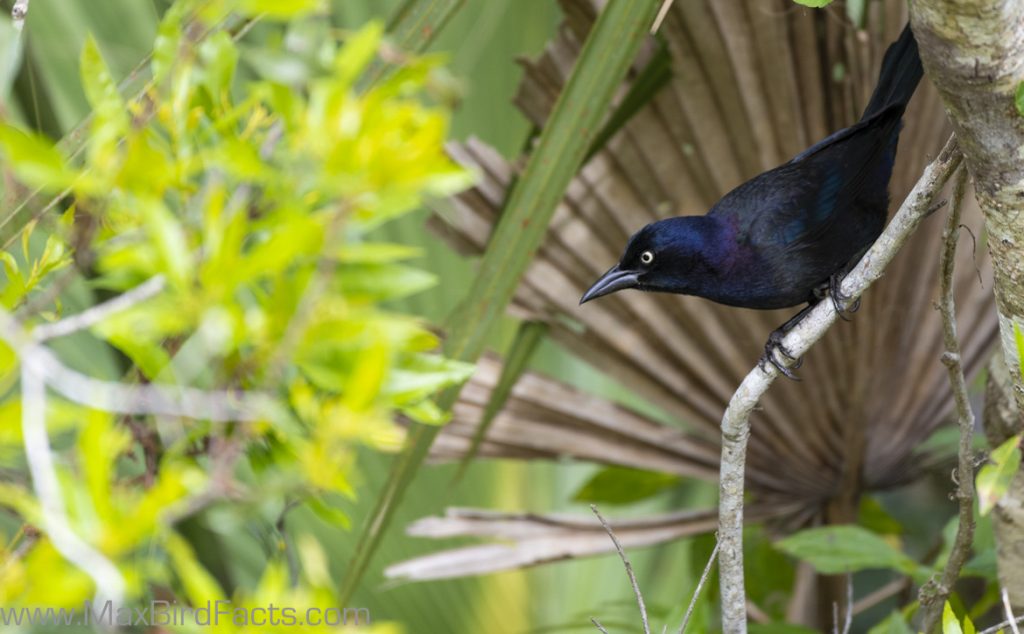
Common Grackles have a very pale yellow iris, whereas Boat-tailed Grackles have a muted brown iris.
The eye-color, along with the overall larger body size and longer tail of the Boat-tailed Grackle, is how I almost always decide which species I am looking at now.
The problem with this is when you get outside of Florida to the East Coast, Boat-tailed Grackles change to having nearly identically pale yellow irises as their cousins.

Because of this, we have to make sure we are looking at the beak length, head crest, tail size and shape, and overall size of the bird.
Grackles can be very hard to tell apart if you don’t have a good look at their tail, but the head can be just as revealing.
Boat-taileds have a slightly pronounced round crown atop their head. This may not seem very important, but it clearly stands out from the more flat-topped head of the Common.
Most of the dimensions on the Common Grackle will be noticeably smaller than those on the Boat-tailed.
Remember, the Boat-tailed Grackle’s tail is roughly the same length as the rest of its body, whereas a Common Grackle’s tail is at most 50% its body length.
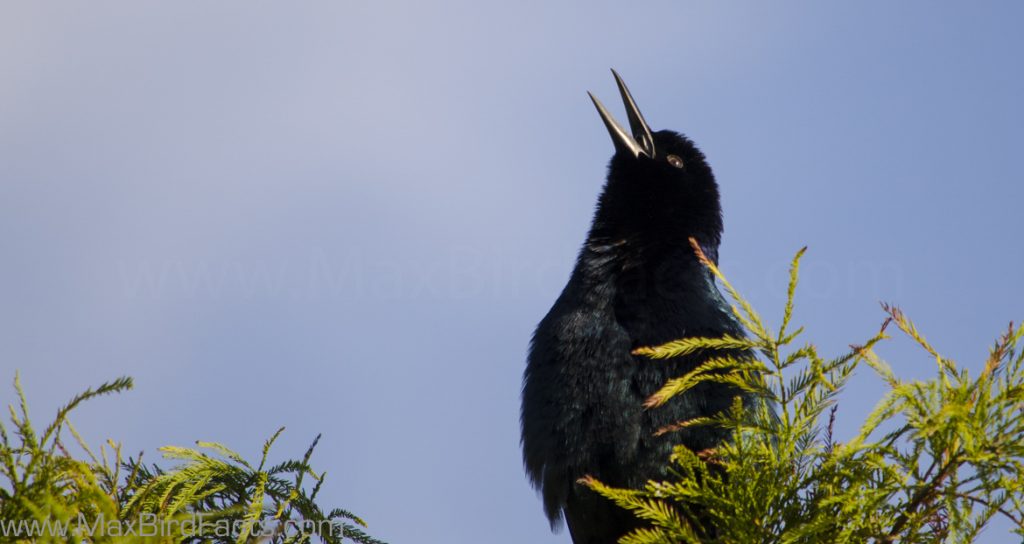
I’m not sure what causes this change in iris pigmentation. In my article Florida Burrowing Owls – Adaptive Engineers, I know a recessive allele in their genes causes their brown eyes.
This means it is doubtful for this color to show, except for smaller populations where this lower frequency often appears.
Maybe this is the same reason we have brown-eyed Grackles in Florida. Still, where the population is more widespread, they show the more dominant yellow iris. Let me know what you think.
These small details might not seem like much, but it could be the difference between a positive or incorrect ID.
Ensure you are looking at the small details even between birds in a group that you might think are the same. You could be surprised to find a species you haven’t added to your list yet.
Grackle vs. Blackbird – The 3 Steps to Remember
1. Body Size and Shape
- Blackbirds will be smaller, chunkier, and more compact in appearance.
- Grackles are about 33% larger, with a lean, lanky, upright form.
2. The Plumage’s Aspect or Coloration
- Male Blackbirds are entirely black except for red, orange, or yellow patches on noticeable parts of their bodies. Carotenoids in the food they eat directly impact this color.
- Male Grackles have an iridescent coloring across their entire body that shines blues, purples, and greens when light hits the feathers just right. The refraction of light causes this iridescence due to the microscopic structure of the feathers themselves.
- Females of both genera are generally dull brown to help camouflage them.
3. Beak Shape and Size
- Blackbirds have a triangular-shaped beak with a very broad base that quickly tapers into a fine point. The beak’s length is just slightly shorter than the bird’s head.
- Grackles have a more cone-shaped beak and a much more gradual tapering from base to tip. The tip of the maxillary beak is also more noticeably curved at the end. The overall length of the beak is equivalent if not longer than the head.
If you keep these three steps in mind next time you are looking at an Icterid, you will be able to figure out if you see a Grackle or a Blackbird!
I hope you take a look at the “Blackbirds” that fly by a little closer now. Let me know what else you want to learn about in the comments!

Make today great!
Max
Discover more from Welcome to MaxBirdFacts.com!!!
Subscribe to get the latest posts sent to your email.

Thank you Max! Your article on the Blackbird v. Grackle ID is very clear and was a pleasure to read.
Thank you David! I’m really glad you enjoyed it!!
You’re so cool! I don’t suppose I’ve learned something like this before. So nice to search out any individual with some authentic ideas on this subject. Really thank you for beginning this up. this website is something that’s needed on the web, someone with a bit of originality.
I didn’t know that.
Wonderful views on that!
I didn’t know that.
Pingback: 5 Members of the Blackbird Family – What is a Blackbird? – Welcome to MaxBirdFacts.com!!!